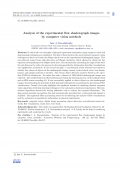In this study, two examples of physical experiment automation using computer vision and deep learning techniques are considered. The first of them involves the use of classical computer vision techniques to detect and track the oblique shock wave on the experimental shadowgraph images. This was achieved using Canny edge detection and Hough transform, which allowed to obtain the line equation corresponding to the oblique shock wave. By automatically calculating the angle of this wave for each frame in the video, the process of extracting quantitative information from flow visualizations was significantly accelerated. In the second example, a convolutional neural network was trained to identify four classes of objects on the shadowgraph images, namely vertical shock waves, bow shocks, plumes, and opaque particles in the flow. The custom object detection model is based on the up-todate YOLOv8 architecture. To realize this task, a dataset of 1493 labeled shadowgraph images was collected. The model showed excellent performance during the learning process, with model precision and mAP50 scores exceeding 0.9. It was successfully applied to detect objects on the shadowgraph images, demonstrating the potential of deep learning techniques for automating the processing of flow visualizations. Overall, this study highlights the significant benefits of combining classical computer vision algorithms with deep learning techniques in the automation of physical experiments. However, classical algorithms demand the writing additional code to extract the required information. The deep neural networks can perform this task automatically, provided that a well-annotated dataset is available. This approach offers a promising avenue for accelerating the analysis of flow visualizations and the extraction of quantitative information in physical experiments.
